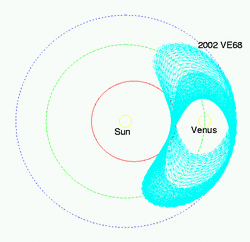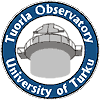|
An international team of astronomers, led by Seppo
Mikkola of Tuorla
Observatory, have discovered that a newly found asteroid is in
a very special orbit, the first of its kind.
The asteroid, called 2002 VE68, was discovered in 2002 at Lowell
Observatory. Like all asteroids, its orbit takes it around the
Sun, with asteroids closer to the sun circling more rapidly and
completing a "year" in a shorter time. The "year" for VE68 is
shorter than the Earth year, clocking in at a little under
225 days.
This is almost exactly the same as the "year" of the
planet Venus --- and it turns out that like synchronised
divers in the olympic games, both VE68 and Venus are
travelling around the Sun nearly in lock-step.
This means that VE68 has a very special property as
seen from Venus: it appears to travel around the Venusian
sky about once every Venus year. If you didn't know that
VE68 is really travelling around the Sun, you might
declare that Venus has a moon (or satellite) of its own.
Because its orbit is centered on the Sun, VE68 is not a
real satellite of Venus in the sense that the moon is a
satellite of the Earth. However, since it appears to
travel around Venus, it is called a
quasi-satellite. Very few quasi-satellites are
known in the Solar Sytem. VE68 is the first
quasi-satellite of Venus; two cases of asteroids in such
orbits are known for the Earth and one for Mars (this is a
special case where the asteroid is going to become a
quasi-satellite in the near future). Tuorla astronomer
Seppo Mikkola has been associated with the discovery of
all of them.
The orbit of VE68 takes it quite far afield from Venus
--- it dives in towards the Sun, passing within the orbit
of Mercury, and travelling outwards just beyond the orbit
of the Earth at its furthest from the Sun. Calculations
performed by Mikkola's team indicate that there is no
danger of impact with either the Earth, Venus or Mercury
for the foreseeable future.
The paper on the discovery of the first Venus
quasi-satellite is by Seppo Mikkola (Tuorla
Observatory), Ramon Brasser (Tuorla Observatory and
York University), Paul Wiegert (The University of
Western Ontario) and Kimmo Innanen (York
University) and has been published in the Monthly
Notices of the Astronomical Society.
Updated August 17th 2004.
|

The figure shows the inner solar system, with the Sun and Venus
marked by yellow circles. The orbits of Mercury, Venus and the
Earth are shown in red, green and blue respectively. In this
figure, the position of Venus has been fixed to always lie in the
horizontal plane, allowing the movement of objects around it to be
seen more clearly. The orbit of VE68 is shown in light
blue. Although more properly in an orbit around the sun, from the
point of view of Venus VE68 follows a regular path which gives it
the appearance of being a Venusian satellite.
|
